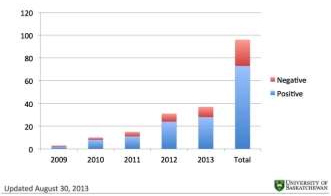



Emergence of Mucohaemorrhagic Diarrhoea Associated with 'B. Hampsonii' in Western Canada
'B. hampsonii' was detected on only a few western Canadian pig farms but it was more commonly diagnosed there than B. hyodysenteriae, University of Saskatchewan researchers told the 33rd Centralia Swine Research Update in January 2014.
Introduction and Objectives
In October 2009, finisher pigs with clinical signs indistinguishable from swine dysentery were observed in two intensive farms in western Canada, reported J.C.S. Harding of the Western College of Veterinary Medicine at the University of Saskatchewan.
Following this discovery, the laboratories at the University expanded diagnostic capabilities to include species-specific quantitative PCR for 'B. hampsonii' clades 1 and 2, agar and broth culture, and speciation based on sequencing of the NADH oxidase (nox) gene from faeces, tissue and isolates.
The objective of this abstract is to report the authors' microbiological and molecular diagnostic findings for samples received between October 2009 and April 2013 from pork farms in western Canada.
Material and Methods
At the University of Saskatchewan, two laboratories work collaboratively on the Brachyspira diagnostic service. Prairie Diagnostic Services Inc. (PDS), the regional veterinary diagnostic laboratory, provides traditional diagnostics including pathology, B. hyodysenteriae and B. pilosicoli PCR, immunohistochemistry and routine culture. The Molecular Microbiology Research Laboratory provides 'novel' Brachyspira testing (Table 1).
| Table 1. Novel Brachyspira testing: Tests performed by the WCVM Molecular Microbiology Research Laboratory |
|
| Assay | Reference |
|---|---|
| Brachyspira culture | (Rubin, 2013) (1) |
| PCR: Brachyspira spp. | (nox; Rohde, 2002 (2) |
| RT-PCR 'B. hampsonii' | (clade 1: Hill, unpublished) |
| (clade 2; Rubin, 2013) (1) | |
| PCR: B. hyodysenteriae | (cpn60; Hill, unpublished) |
Diagnostic testing has evolved over time based on available resources. 'B. hampsonii' clade 2 RT-PCR and nox-based sequencing was introduced in 2010; Brachyspira culture in 2011. In 2012, 'B. hampsonii' clade 1 RT-PCR was initiated. Collectively, we aim to understand if and what Brachyspira species are present in a given sample, and provide confidential tracking of cases by farm, system and region.
Samples are received from veterinarians, generally following overnight delivery. Although the authors encourage clients to submit carcasses or fresh/fixed intestinal tissues enabling a thorough work-up including histopathology and special stains, the most common sample received is faeces collected from pen floors. A survey accompanying the submission enables the collection of clinical data including fecal consistency scores, medication history and age.
Results
A total of 377 samples from 68 farms in Alberta (221), Saskatchewan (86), Manitoba (49) and British Columbia (15) were received since 2009. A 'sample' refers to faeces, tissue, or carcasses from farms demonstrating loose, bloody or mucoid diarrhoea in nursery and grow-finish stages.
Approximately two-thirds of samples were submitted by inter-related farms within one of several productions systems. Two-thirds of samples were faeces; the remainder tissues or carcasses.
One or more species of Brachyspira were detected or isolated in 80 per cent of farms and 59 per cent of samples. 'B. hampsonii' was detected in 34 per cent of samples; about nine per cent clade 1, 26 per cent clade 2, and one per cent dual detection of clade 1 and 2. By contrast, B. hyodysenteriae and B. pilosicoli were detected only in 11 per cent and 13 per cent of samples, respectively.
B. murdochii, some strongly beta haemolytic, were detected in around nine per cent of samples; B. intermedia from four per cent of samples. Multiple species were detected in 15 per cent of samples. Neither 'B. suanatina' nor Serpulina sp. P280/1 were detected or isolated.
The number of samples submitted increased from 29 in 2010 to 144 in 2012. To date, 'B. hampsonii' has been detected or isolated from 32 farms in western Canada.

in western Canada by University of Saskatchewan (2009-2013)
Discussion
As of January 2013, there were approximately 2,500 farms raising pigs in western Canada. The 32 farms on which the authors have detected or isolated 'B. hampsonii' are few by comparison but do represent influential industry players.
Some of these farms however are inter-related, and some clustering of species within production systems is evident. That being said, 'B. hampsonii' is more commonly diagnosed in western Canada than B. hyodysenteriae based on diagnostics completed to date.
References
- Rubin J.E. et al. 2013. PLoS One. 8:e57146.
- Rohde J. et al. 2002. J. Clin. Microbiol. 40:2598-2600.
Reference
Harding J.C.S., C. Fernando, J. Rubin and J.E. Hill. 2014. Emergence of mucohaemorrhagic diarrhoea associated with 'B. Hampsonii' in Western Canada. Proceedings of 33rd Centralia Swine Research Update. II-22-II-23.
Further Reading
Read other papers from the Centralia Swine Research Update 2014 by clicking here.
Find out more about swine dysentery by clicking here.
June 2014








